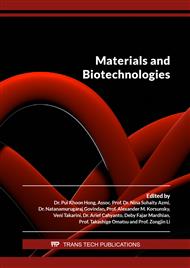[1]
D. Perremans, E. Trujillo, J. Ivens, A.W. Van Vuure. Effect of discontinuities in bamboo fibre reinforced epoxy composites. Composites Science and Technology. 2018; 155: 50-57.
DOI: 10.1016/j.compscitech.2017.11.033
Google Scholar
[2]
Jianyong Lin, Zexun Yang, Xiaoxia Hu, Gonghua Hong, Shuangbao Zhang, and Wei Song. The Effect of Alkali Treatment on Properties of Dopamine Modification of Bamboo Fiber/Polylactic Acid Composites. Polymers. 2018; 10.
DOI: 10.3390/polym10040403
Google Scholar
[3]
Linhua Zou, Helena Jin, Wei-Yang Lu, Xiaodong Li. Nanoscale structural and mechanical characterization of the cell wall of bamboo fibers. Materials Science and Engineering C. 2009; 29: 1375-1379.
DOI: 10.1016/j.msec.2008.11.007
Google Scholar
[4]
Haiyang Zhang, Jin Liu, Zhiqiang Wang, Xiaoning Lu. Mechanical and thermal properties of small diameter original bamboo reinforced extruded particleboard. Materials Letters. 2013; 100: 204-206.
DOI: 10.1016/j.matlet.2013.03.028
Google Scholar
[5]
Kin-tak Lau, Pui-yan Hung, Min-Hao Zhu, and David Hui. Properties of natural fiber composites for structural engineering applications. Composites Part B. 2018; 136: 222-233.
DOI: 10.1016/j.compositesb.2017.10.038
Google Scholar
[6]
G.Wang and F.Chen. Development of bamboo fiber-based composites. Advanced High Strength Natural Fiber Composites in Construction. 2017;10: 235–253.
DOI: 10.1016/b978-0-08-100411-1.00010-8
Google Scholar
[7]
Kim L. Pickering. Properties and performance of natural-fibre composites. (2008).
Google Scholar
[8]
A.R. Horrocks and D.Price Fire retardant materials. (2001).
Google Scholar
[9]
Dagang Liu, Jianwei Song, Debbie P. Anderson, Peter R. Chang, Yan Hua. Bamboo fiber and its reinforced composites: structure and properties Cellulose. 2012; 19: 1499-1480.
DOI: 10.1007/s10570-012-9741-1
Google Scholar
[10]
Yan Yu, Hankun Wang, Fang Lu, Genlin Tian, Jinguo Lin. Bamboo fibers for composite applications: a mechanical and morphological investigation. J Mater Sci. 2014; 49: 2559-2566.
DOI: 10.1007/s10853-013-7951-z
Google Scholar
[11]
Krishan K. Chawla. Fibrous Materials. (2016).
Google Scholar
[12]
Diana P. Ferreira, Juliana Cruz, and Raul Fangueiro. Surface modification of natural fibers in polymer composites. Green Composites for Automotive Applications. 2019; 3-33.
DOI: 10.1016/b978-0-08-102177-4.00001-x
Google Scholar
[13]
J. Kaima, I. Preechawuttipong, P. Jongchansitto and N. Charoenloe. Effect of Chemical Solution on Tensile Strength of Bamboo Fiber. Materials Science and Engineering. 2020; 886: 012061.
DOI: 10.1088/1757-899x/886/1/012061
Google Scholar
[14]
Eylem D. Tomak, Elif Topaloglu, Esat Gumuskaya, Umit C. Yildiz, Nurgul Ay. An FT-IR study of the changes in chemical composition of bamboo degraded by brown-rot fungi International Biodeterioration & Biodegradation. 2013; 85: 131-138.
DOI: 10.1016/j.ibiod.2013.05.029
Google Scholar
[15]
Parnia Zakikhani, R. Zahari, M.T.H. Sultan, D.L. Majid. Materials and Design. 2014; 63: 820-828.
DOI: 10.1016/j.matdes.2014.06.058
Google Scholar
[16]
Kazuya Okubo, Toru Fujii, and Yuzo Yamamoto. Development of bamboo-based polymer composites and their mechanical properties. Composites Part A. 2004; 35: 377-383.
DOI: 10.1016/j.compositesa.2003.09.017
Google Scholar
[17]
Ge Wang, Yan Yu, Sheldon Q. Shi, Jinwu Wang, Shuangping Cao, Haitao Cheng. MICROTENSION TEST METHOD FOR MEASURING TENSILE PROPERTIES OF INDIVIDUAL CELLULOSIC FIBERS. Wood and Fiber Science. 2011; 43: 251-261.
Google Scholar
[18]
Zhuo-Ping Shao, Chang-Hua Fang, Sheng-Xia Huang, Gen-Lin Tian. Tensile properties of Moso bamboo (Phyllostachys pubescens) and its components with respect to its fiber-reinforced composite structure. Wood Sci Technol. 2010; 44: 655-666.
DOI: 10.1007/s00226-009-0290-1
Google Scholar
[19]
O.P. Balogun, J.A. Omotoyinbo, K.K. Alaneme, I.O. Oladele, B.J. Babalola. The effect of chemical treatment on tensile properties of soil retted entada mannii fibres Ameican. Journal of Engineering Research (AJER). 2015; 4: 168-175.
Google Scholar
[20]
Kaima J, Preechawuttipong I, Peyroux R, Jongchansitto P, Sillard C, Viguie J, et al. Effect of NaOH Concentration on Tensile Strength of Bamboo Hand Sheet. Materials Science Forum. 2022; 1067:113–8. https://doi.org/10.4028/p-8oo3r9.
DOI: 10.4028/p-8oo3r9
Google Scholar



